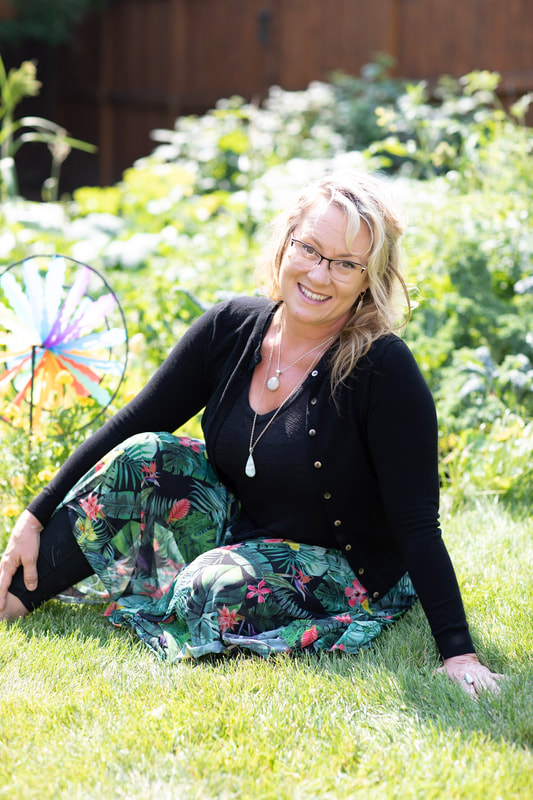|
The breath is a powerful source of transformation. The rate and rhythm of the breath are intimately connected to our mental & emotional states (Brown, Gerbarg, 2012). Just as the emotions and the mind cause the breath to vary, by consciously controlling the breath, we gain control over our mind and our emotions (Trinity College Dublin. 2018). In my Art Therapy practice, one of the first things I pay attention to when I first see a client is how they are breathing. Noticing the breath says a lot about how a person is feeling in the moment. Notice how you are breathing right now. Is your breath shallow and regulated to the upper chest? Or is it deep and concentrated in the belly? How do you feel in this moment? One way to stabilize one’s self when feeling a sense of anxiety or stress (where the breath becomes shallow and centralized in the upper chest) is to stop and focus your attention on the breath filling the lower belly with deep inhales through the nose (Bhajan, 2010). Combining this modality of breath-work with the eye gaze by noticing ten things in the room and mentally or aloud saying their colour and what they are, as well as pressing the feet into the floor, will activate your parasympathetic nervous system and bring you into a feeling of calmness (Brantley & el 2007). On the other hand, when a person is feeling the depths of depression and despair, they may sigh a lot with an almost a sense of defeat. The breath here is usually more in the belly. To bring more life force or prana into the body, I recommend sitting up straight, lengthening the spine and with an open mouth breathing deep and forcefully into the upper chest. This activates the sympathetic nervous system and creates a sense of alertness and aliveness (Levine & Frederick, 2005). Taking this one step further, I would invite the client to raise both arms above the head as they inhale, allowing the eye gaze to follow the hands while keeping the chin level (Assay, Rosenberg & Rand, 1987). Five to ten of these breaths and one will feel a tingling in the whole body, with the eye focus becoming clearer and a sense of elation. So how and why does this happen?
The respiratory system is one of the only major systems in the body which is usually involuntary, but which can also be voluntarily controlled (Levine & Frederick, 1997). Our heart also beats involuntarily but if we want to control it, we slow down our breath bringing us into a state of calmness and relaxation. Breath is the life force that keeps us going. Without breathing we would die. When we are able to control the breath, we are able to control the way we feel in the moment and develop a sense of control over stress levels. Your rate of breathing and state of mind are inseparable. Using a full yogic breath or pranayama techniques and especially adding mantra or chanting, reprograms your whole cellular memory (Khalsa & Lumpkin, 2015). This is one of the reasons that Kundalini Yoga is so powerful! By consciously directing the flow of our breath, not only are we transporting life force, vitamins, minerals and glandular secretions to our vital organs, we are also transforming the way we think and the way we feel (Bhajan, 2003). For thousands of years, ancient wisdom techniques from the east have exalted the virtues of breath-focused practices, such as pranayama and meditation to have numerous cognitive benefits including an increased ability to focus, decreased mind wandering, improved arousal levels, more positive emotions, decreased emotional reactivity, and many other benefits (Immergut & Yates Culadasa, 2017) . What did they know that we are just now validating as scientifically proven? Well, a new study by researchers at Trinity College Institute of Neuroscience and the Global Brain Health Institute at Trinity, Dublin explains for the first time the neurophysiological link between breathing, cognition and emotion. The research shows that the way we breathe, directly affects the chemistry of our brains in a way that can enhance our attention and improve our brain health. What was found is that the levels of a natural chemical messenger in the brain called noradrenaline, is directly affected by breath. This chemical messenger is released when we are challenged, curious, exercised, focused or emotionally aroused, and, if produced at the right levels, helps the brain grow new connections (Trinity College Dublin, 2018, May 10)! Outlined here by PhD candidate at the Trinity College Institute of Neuroscience and lead author of the study, Michael Melnychuk: "Practitioners of yoga have claimed for some 2,500 years, that respiration influences the mind. In our study we looked for a neurophysiological link that could help explain these claims by measuring breathing, reaction time, and brain activity in a small area in the brainstem called the locus coeruleus, where noradrenaline is made. Noradrenaline is an all-purpose action system in the brain. When we are stressed we produce too much noradrenaline and we can't focus. When we feel sluggish, we produce too little and again, we can't focus. There is a sweet spot of noradrenaline in which our emotions, thinking and memory are much clearer. This study has shown that as you breathe in, locus coeruleus activity is increasing slightly, and as you breathe out it decreases. Put simply this means that our attention is influenced by our breath and that it rises and falls with the cycle of respiration. It is possible that by focusing on and regulating your breathing you can optimize your attention level and likewise, by focusing on your attention level, your breathing becomes more synchronized." Ian Robertson, Co-Director of the Global Brain Health Institute at Trinity and Principal Investigator of the study added: "Yogis and Buddhist practitioners have long considered the breath an especially suitable object for meditation. It is believed that by observing the breath, and regulating it in precise ways -- a practice known as pranayama -- changes in arousal, attention, and emotional control that can be of great benefit to the meditator are realized. Our research finds that there is evidence to support the view that there is a strong connection between breath-centered practices and a steadiness of mind." Even more exciting in this area of research was the understanding and uncovering of how breath-work and meditation may have an effect of the aging of the brain. Ian Robertson went on to speculate that, "Our findings could have particular implications for research into brain ageing. Brains typically lose mass as they age, but less so in the brains of long-term meditators. More 'youthful' brains have a reduced risk of dementia and mindfulness meditation techniques actually strengthen brain networks. Our research offers one possible reason for this -- using our breath to control one of the brain's natural chemical messengers, noradrenaline, which in the right 'dose' helps the brain grow new connections between cells. This study provides one more reason for everyone to boost the health of their brain using a whole range of activities ranging from aerobic exercise to mindfulness meditation." It is always exciting to witness the acceptance of Eastern healing modalities as being scientifically proven in our Western medical system. My personal feeling is that this mirrors our global understandings and acceptance of one another, a sharing of information rather that a fear that another’s information will taint or somehow invalidate our own. I look forward to more research being done in the areas of mindfulness, mediation, yoga and neuroscience to help heal and transform our brains and the way we engage in the world. “If there is anything divine in you, it’s your breath” Yogi Bhajan. May all beings be Blessed, Charmaine Husum (Livdeep Kaur) www.centreoftheheart.com Charmaine Husum (Livdeep Kaur) runs a private Art Therapy practice (Centre of the Heart) in Calgary Alberta. She is also an Artist, Kundalini Yoga teacher and trained in the somatic approach of Integrative Body Psychotherapy and Reiki. Her approach to healing is within a Humanistic, Feminist lens that believes the power of healing lies within the individual. Her current research enthusiasms are in neuroplasticity, neuroscience, epigenetics, mystical integration and intergenerational trauma; on which she is currently writing a book and creating online courses. She specializes in working with trauma and symptoms of PTSD and C-PTSD as well as Autism, Depression, Anxiety, Eating Disorders, Addiction and other mental health symptoms. She is honoured to offer a workshop at The Sanctuary Space Saturday May 11th, 2019 on Brain Health using Kundalini Yoga and Art Therapy techniques and looks forward to meeting you all soon. References Assay, D., Lee Rosenberg, J., Rand, M. (1987). Body, Self, and Soul: Sustaining Integration. Lake Worth, FL: Humanics Publishing Group Brantley, J. MD, McKay, M. PhD, Wood, J.C. PsyD, (2007). The Dialectical Behavior Therapy Skills Workbook: Practical DBT Exercises for Learning Mindfulness, Interpersonal Effectiveness, Emotion Regulation, and Distress Tolerance. Oakland, California: New Harbinger Publications Inc. Brown, R., Gerbarg, P. (2012). The Healing Power of the Breath: Simple Techniques to Reduce Stress and Anxiety, Enhance Concentration, and Balance Your Emotions. Boulder, Colorado: Shambala Publishing. Bhajan, Y. (2003). The Aquarian Teacher: Level One Instructor Book. Santa Cruz NM: Kundalini Research Institute Bhajan, Y. (2010) Transformation Vol. 1: Mastering the Self, edited by Sat Purkh Kaur Khalsa, Santa Cruz, NM: Kundalini Research Institute. Immergut, M. PhD, Yates Culadasa, J. PhD (2017). The Mind Illuminated: a Complete Meditation Guide Integrating Buddhist Wisdom and Brain Science for Greater Mindfulness. London: Hay House Publishing Khalsa Kaur, J, Lumpkin, N. (2015). Enlightened Bodies: Exploring Physical and Subtle Human Anatomy.Santa Cruz, NM: Kundalini Research Institute Levine, P., & Frederick, A. (1997). Waking the Tiger: Healing Trauma. Berkley, California: North Atlantic Books. Levine, P., & Frederick, A. (2005). Healing Trauma: A Pioneering Program for Restoring the Wisdom of Your Body. Boulder, Colorado: Sounds True Inc. Nhất, H., Ho, M., & Vo-Dinh, M. (1987). The miracle of mindfulness: An introduction to the practice of meditation. Boston: Beacon Press. Shannahoff-Khalsa, D. (2012). Sacred Therapies: The Kundalini Yoga Meditaion Handbook for Mental Health. W.W. Norton & Company: New York, London. Singh Khalsa, D. M.D. (2013). This is Your Brain on Yoga by the Founding President and Medical Director Alzheimer’s Research and Prevention Foundation FIRST POSTED IN www.SPIRITVOYAGE.com on November 5, 2013, Retrieved April 24, 2019 from https://kathrynmccuskerkundalini.com/this-is-your-brain-on-yoga/ Trinity College Dublin. (2018, May 10). The Yogi masters were right -- meditation and breathing exercises can sharpen your mind: New research explains link between breath-focused meditation and attention and brain health. ScienceDaily. Retrieved April 28, 2019 from www.sciencedaily.com/releases/2018/05/180510101254.htm Journal Reference:
0 Comments
Leave a Reply. |
AuthorCharmaine Husum runs a private Art Therapy practice online and in Calgary Alberta. She is also an Artist, Kundalini Yoga teacher and trained in the somatic approach of Integrative Body Psychotherapy, Reiki and Mystical Integration. Her current research enthusiasms are in neuroplasticity, neuroscience, epigenetics, mystical integration and intergenerational trauma; on which she is currently writing a book and creating online courses. She specializes in working with trauma and symptoms of PTSD and C-PTSD as well as Autism, Depression, Anxiety, Eating Disorders, Addiction and other mental health symptoms. Archives
July 2023
Categories
All
|
"Sometimes the smallest step in the right direction
ends up being the biggest step of your life.
Tip toe if you must but take the step".
- Naeem Callaway
© 2022-24 Centre of the HeArt
Website Design By: IA Creative
Website Design By: IA Creative


 RSS Feed
RSS Feed



